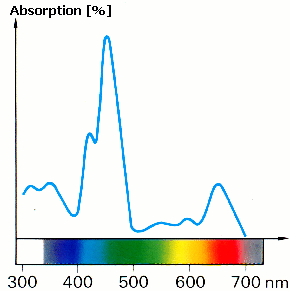|
|
 |
|
|
|
 |
| |
|
|
 |
Lower Atmosphere
Read more |
Worksheet 2
The interrelation of light, absorption and colour
|
|
|
|
|
 |
 |
 |
|
Figure 1: spectrum of white light
© 2004 Seesing, Tausch; Universität Duisburg-Essen, Duisburg [Lit:Tausch, von Wachtendonk: Chemie SII, Buchner Verlag, Bamberg 1993]
|
|
Visible light is a certain part of the spectrum of electromagnetic radiation. It consists of tiny energy units called light quanta or photons. The energy of a photon is determined by its wavelength. If the same amount of photons of all wavelengths of the visible spectrum meets our eyes, we perceive the light as white light. An object also appears white if it reflects all the different photons white light consists of in a regular way. With a prism or a diffraction grid (a great number of thin, parallel lines, e.g. a CD) wavelengths can pass or be reflected at different angles. We then see a spectrum with all colours arranged according to their energy content (see Fig.1). If a part of the light of a certain energy is absorbed, we perceive the complementary colour of the absorbed light. |
|
|
T 1 |
Which visible colour belongs to each of the spectra below? |
|
 |
 |
|
© 2004 Seesing, Tausch; Universität Duisburg-Essen, Duisburg [Lit:Tausch, von Wachtendonk: Chemie SII, Buchner Verlag, Bamberg 1993]
|
|
 |
|
|
In nature many things appear coloured. Most of them absorb in several areas of the visible spectrum. Usually the absorption in these areas is not of the same quantity (see Fig. 2). This results in characteristic absorption spectra that can be used for the identification of substances. Furthermore, two substances that are made up of the same components can sometimes be of different brightnesses.
|
|
T 2 |
Suggest a hypothesis why two samples of the same substance appear differently bright and give reasons for your hypothesis. Draw the spectrum of a "darker" chlorophyll b into Fig 2. |
|
 |
 |
 |
|
Figure 2: absorption spectrum of chlorophyll b
© Tausch, von Wachtendonk: Chemie SII, Buchner Verlag, Bamberg 1993
|
|
|
Basic spectrometry
Spectroscopy is used for the identification of substances. In the laboratory you can examine different substances with a photometer (also called spectrometer) in order to be able to find them again in satellite measurements of the atmosphere of the earth. (c.f. the spectrum of the atmosphere made by the GOME satellite at the ESPERE-webpages: section on "Lower Atmosphere / more / 1.Oxidants".)
A photometer consists of the elements shown in Fig.3:
|
 |
 |
|
Figure 3:
Set-up of a photometer A: light source; B: monochromator (prism or diffraction grid); C: aperture; D: cuvet with sample; F: photosensor; G: amplifier with calibrated reading showing the EXTINCTION; Io: light intensity in front of the sample I: light intensity behind the sample The measured value EXTINCTION gives the relation of the light intensity that has passed (I) and the original light intensity (Io).
© 2004 Seesing, Tausch; Universität Duisburg-Essen, Duisburg [Lit:Tausch, von Wachtendonk: Chemie SII, Buchner Verlag, Bamberg 1993]
|
Depending on the apparatus and the tuning the measured values are given either in percent or logarithmically.
|
 |
|
|
There are many parameters that can be adjusted in a photometer. One can choose between different lamps, especially for apparatuses that also work in the UV-region of the electromagnetic spectrum, or the width of the aperture, the position of the monochromator, the temperature of the sample, and the amplification. One can also change the thickness of the sample by taking cuvets of different geometries. It remains the same though if the same cuvets are used.
|
T 3 |
What do you have to change exactly and continuously in order to get a spectrum as shown in Fig. 2? Give reasons for your answer. | |
|
The scientists Johann Heinrich Lambert (1728-1777) and August Beer (1825-1863) set up a law that was named after them, the law of Lambert and Beer:
|
 |
 |
|
E: extinction; ε molar extinction coefficient (constant that is dependent on the wavelengths and on the character of the absorbing substance); d: layer thickness of the sample; c: concentration of the absorbing substance
|
|
T 4 |
Give an interpretation of your hypothesis in T 2 and keep in mind the law of Lambert and Beer. Which proportionality in relation to the extinction can be experimentally produced and used? |
|
T 5 |
Discuss your results from T 3 and 4! |
|
|
About this page:
Authors: M. Seesing, M. Tausch - Universitšt Duisburg-Essen, Duisburg / Germany
Scientific reviewing: Dr. Mark Lawrence - Max Planck Insitute for Chemistry, Mainz - 2004-05-05
Last update: 2004-05-13 |
|
 |
|









